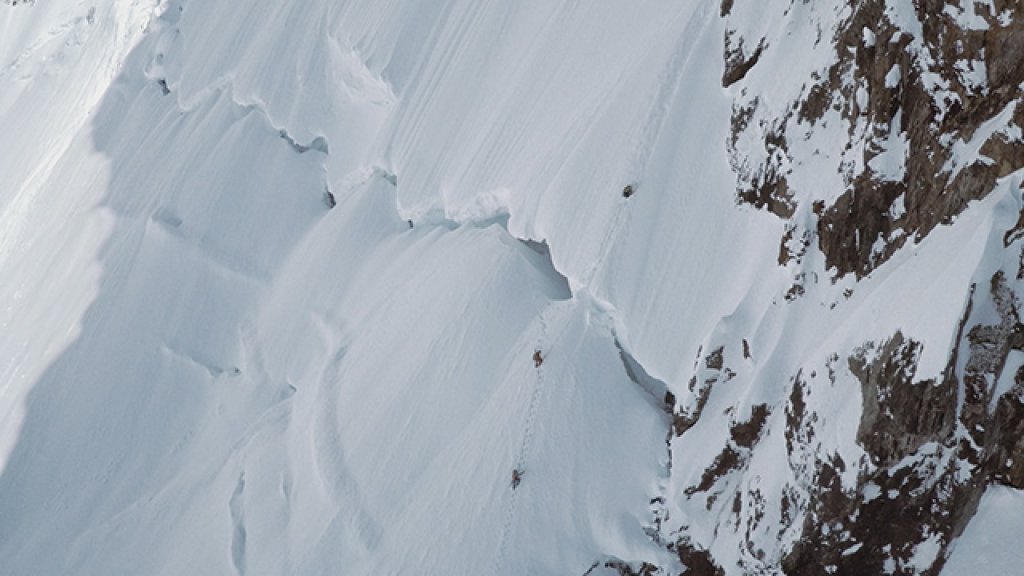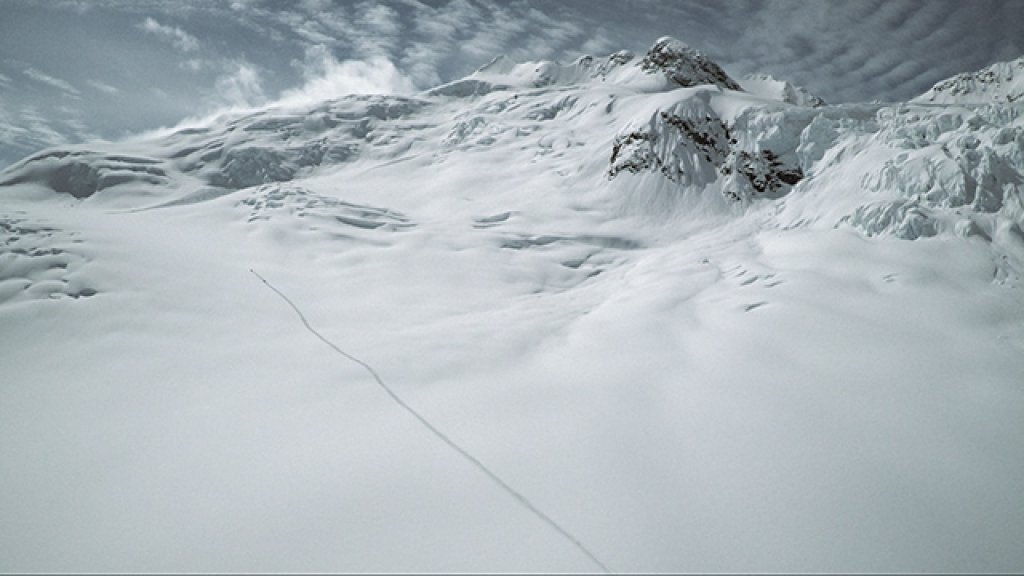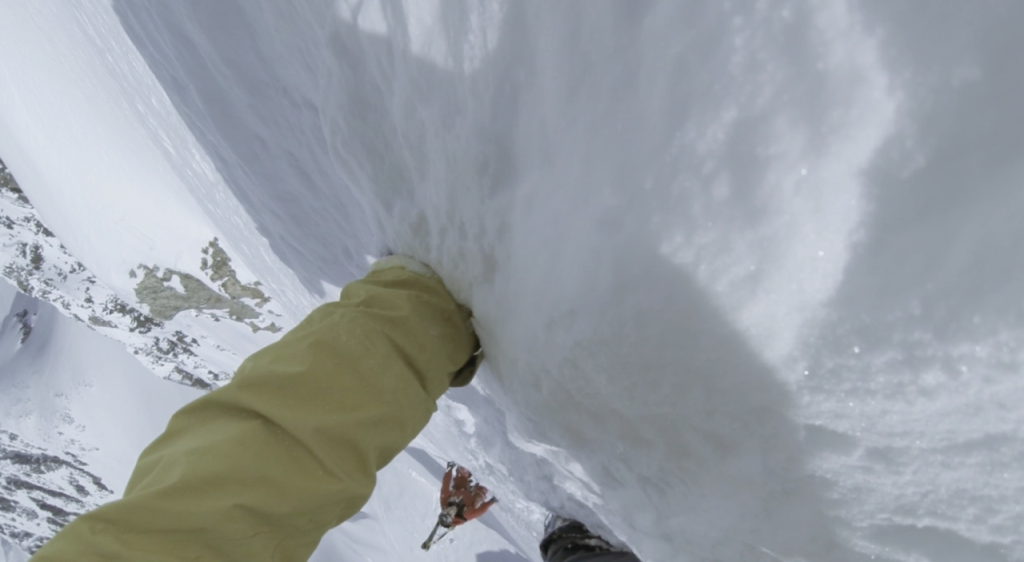Filme über das Skifahren fallen im Englischen ja unter den Überbegriff Skiporn. Das mit dem Porno bezieht sich da wohl auf die oft wenig bis nicht existente Rahmenhandlung und das vor-lauter-Moneyshots-bloß-nicht-nachdenken-müssen. Es gibt auch gelegentlich Filme, die das anders machen, oder es zumindest versuchen. Die Komplexität der Handlung liegt dann meistens irgendwo zwischen „Warum liegt denn hier Stroh" und Fifty Shades of Grey.
Conquering the Useless schafft es dagegen ungefähr auf das Niveau dieser typischen französischen Arthouse Filme, die in den USA wegen zuviel Nacktheit nicht ins Kino kommen – immer noch ein bisschen Porno-mäßig und auf die Ästhetik bedacht, aber Figuren entwickeln sich, haben nachvollziehbare Sorgen und Ängste und alles wirkt weniger künstlich.
Der Plot
Cody Townsend ist nach seiner berühmten Line durch die enge Rinne und jahrelangem Heliskiing ein wenig ausgebrannt und beschließt, dass er jetzt mal was anderes macht und auf den Heli verzichtet. So weit, so gut, so Jeremy Jones. Da er sich größere Aktionen ohne Guide und sonstigen Support allein nicht zu traut, überzeugt er seine skibergsteigerisch erfahrenen Kollegen Chris Rubens und Dave Treadway von einem längeren Trip in die Wildnis. Die drei fahren mit zwei Filmern per Skido in ihr Basecamp und erkunden von dort die Gegend, wiederum mit Skidos und zu Fuß. Elyse Saugstadt, Gattin des Hauptprotagonisten Townsend, beweist in einem Intro-Segment, dass sie mit den Jungs durchaus mithalten kann, ist aber beim Skido Trip nicht dabei.
Was Conquering the Useless von anderen Produktionen der Art „krasses Adventure" unterscheidet, ist die unaufgeregte Ehrlichkeit.
Townsend, der auch als Erzählerstimme fungiert, betont stets, wie wichtig die Erfahrung der beiden anderen ist und wie viel er von ihnen lernt. Man sieht das Team umdrehen, zweifeln und über ihre Bedenken reden. Das Abschlusssegment bilden Aufstieg und Abfahrt durch ein sehr steiles Face. Während sie sich fertig machen, sind alle sichtbar nervös und Dave Treadway lässt anklingen, dass er eigentlich lieber zu hause bei seiner Familie wäre und in Zukunft auf solche Aktionen verzichten wird.
Niemand wird zum Helden stilisiert und alle treten als gleichwertige Team-Mitglieder auf, anders als beispielsweise in einigen der Jeremy Jones Filme. Ebenso fehlt jegliche künstliche Dramatik und an Star Wars Schlachten erinnernde Filmmusik, wie man sie kürzlich zum Beispiel im eher wunderlichen Onekotan – The lost Island bewundern konnte.
Vielleicht rührt der sympathische Gesamteindruck daher, dass bei Conquering the Useless die Athleten wohl auch für die Gestaltung des Films verantwortlich waren und keine große Produktionsfirma irgendwelche special effects eingebaut hat. Uns hat es jedenfalls gefallen und wir haben uns bei Chris Rubens erkundigt, wie das mit dem Film so war und warum man manchmal ganz gern ein bisschen Angst hat.
PG: How long were you at the camp and how many downdays did you have?
CR: I think we were in camp for about 12 days, in that time we had 2 mostly sunny days and one afternoon. The weather was quite challenging.
PG: Exactly how sketchy was the sledding on the glacier?
CR: On the days that it was cold enough to freeze over night it wasn't so bad, but coming down at the end of the day was pretty terrifying. I'm not sure if science would back this up but we felt that keeping our speed up and then only stopping in very safe places was our only option. But yeah, it might have been a little on the sketchy side.
PG: In the movie it sounds like it's a completely different thing when you climb something rather than get dropped on top with a helicopter, quotes go from "I've skied plenty of things this steep but never climbed anything like it" to "humans don't belong on this wall". It's the same wall whether you climb it first or not, what's the big difference?
CR: It's a much slower process when you are going to climb something. You end up spending a lot more time on the face or line that you are skiing, so you are battling nerves for a much longer amount of time. When you are helicopter skiing you are only focused on how you are going to make it down the line safely. Now you have to figure out how you are going to get up it, the best and most safe way, which isn't always super obvious. All this combined makes climbing lines a lot more fulfilling, being in the moment for such a long period of time, all the build up - and then accomplishing the goal is very rewarding.
The feeling seems to last for days if not years while most of the stuff that I have skied out of a helicopter lasts about 5 minutes, until you jump into the helicopter to ski another gnarly line.
PG: In the beginning Cody say he wants to find something that scares him. Why is fear desirable?
CR: Good question, when I think about it in front of my computer the thought of skiing gnarly lines terrifies me, because I think of all the bad things that can happen. When I'm in the field I look at the mountains very systematically and move from one safe zone or decision making point to the next. All the while I'm gathering information from my environment to make the best decisions possible. As I gain more confidence in what I'm doing I get less scared. I think I'm drawn to that aspect that humans really aren't suppose to be there, but some how with our gear and skills we are. I also think the feeling you get from all of this is very authentic and puts you in touch with nature. That was a long answer but I guess I'm still trying to answer that question.
PG: You call the last line "the best and scariest skiing ever". Does skiing have to be scary to be good?
CR: No absolutely not, my favourite skiing is pillow skiing in the trees in epically deep powder. I like it because it has a lot less risk and I can just enjoy the skiing portion of it. But I also really enjoy skiing big scary lines when the conditions are good.For me though it is about the snow, I don't need to go ski something just to say I skied it. I want to ski it in good powder, those are the days that I cherish.
PG: Would you agree that there is a good kind of scary and a bad kind? If so, what's the difference?
CR: Yah, there is a really fine line there, and it is probably the internal battle that is going on in lines like this. Making sure that you are scared for the right reasons. I was scared at the top of that line because it was steep and we had a lot of air below us. But I wasn't scared of the snow conditions, there was no slab, no instabilities, so I had no fear there. That's what I call bad scared, also known as sketchy.
PG: What was the scariest thing you've ever done?
CR: I don't know but looking back probably most of my teenage years.
PG: The premise of the film is that Cody wants to "drop the glitz" and skip the heli to go on a self-guided, self-supported adventure. I may be wrong but if it's mostly about mixing things up, most of your audience would probably like to drop the slogging and take the glitz. Do you find that disconnect weird?
CR: Hahaha..yah its funny, I have definitely spent my fair share of time flying around the mountains in helicopters. It is awesome, no doubt.
And when I say that I'm not that into heli skiing I feel like a jaded dick.
There are a lot of people that would give a lot to do the same. But I guess we are lucky enough to have done both and you quickly find that you don't get the same fulfillment out of helicopter skiing. When you get to the top of a run that you have hiked to, it seems to be really good and fun no matter what the conditions. In a heli you don't have that same appreciation of getting there so it is easy to complain.
PG: Cody apparently wants to do more ski mountaineering, Dave wants to do less. What about you?
CR: I kinda hate the words "ski mountaineering", I think Ptor (Spricenieks, Anm. d. Red.) said it best: "other avenues of skiing should be labeled (lift skiing, piste skiing.etc), to me this is just skiing".I don't go out with certain goals to go ski something, I want to ski something that I'm stoked on skiing. If I need a rope or crampons for the job then so be it, but most of the time I just like skiing powder.
PG: Planning any particular projects?
CR: Always something in the works with Salomon FreeSki TV and maybe another project with Cody.
PG: There have been some prominent deaths in the skiing and mountaineering world over the last years. Has anything fundamental changed since the days of the early steep skiers (e.g. people pushing too hard, modern gear), or are we just more aware of what people are doing thanks to the internet and when someone dies we hear about it?
CR: I think people have been dieing in the mountains for a very long time. It's a place where if you push too hard or have some bad luck the consequences are death.
From my experience, combining ski filming and ski mountaineering is a very tricky balance.
A lot of the time in the mountains, moving fast is your safety. Trying to film definitely takes that out of the equation. But each time a friend dies it shakes your whole belief system right to the roots.
PG: The movie is pretty different form typical ski flicks, comparatively there is a lot of focus on difficulties, turning around, worrying, being scared. Why make a movie like that?
CR: I'm not sure that we intended for the movie to come out quite like this. It was fairly organic in the fact that the filmers (www.team13.com, Athan Merrik ) were capturing what was happening. I think they did an exceptional job of always rolling cameras and audio to capture those little moments that are generally lost in ski movies. Everything you mentioned above happens all the time but isn't always captured or shown. I think it is cool because when I see something cool in this world, I want to see the why and how.
PG: What does the title mean to you?
CR: I haven't actually read the Conquistador of the Useless... Mostly what we are doing and are addicted to is pretty useless, but we are all getting more addicted to it every year.
PG: What's your favourite ski movie ever and why?
CR: I'm biased but I really like Into the Mind by the Sherpas. A lot of it was lost on most people but the deeper message was very interesting and something that we battle with everyday in the mountains.
PG: Anything else you want to tell us?
CR: Thanks for the interview, really great questions, go watch the movie and I hope everyone has a great powder filled winter.
Den Film gibt es bei i-tunes, vimeo und amazon zu kaufen.


